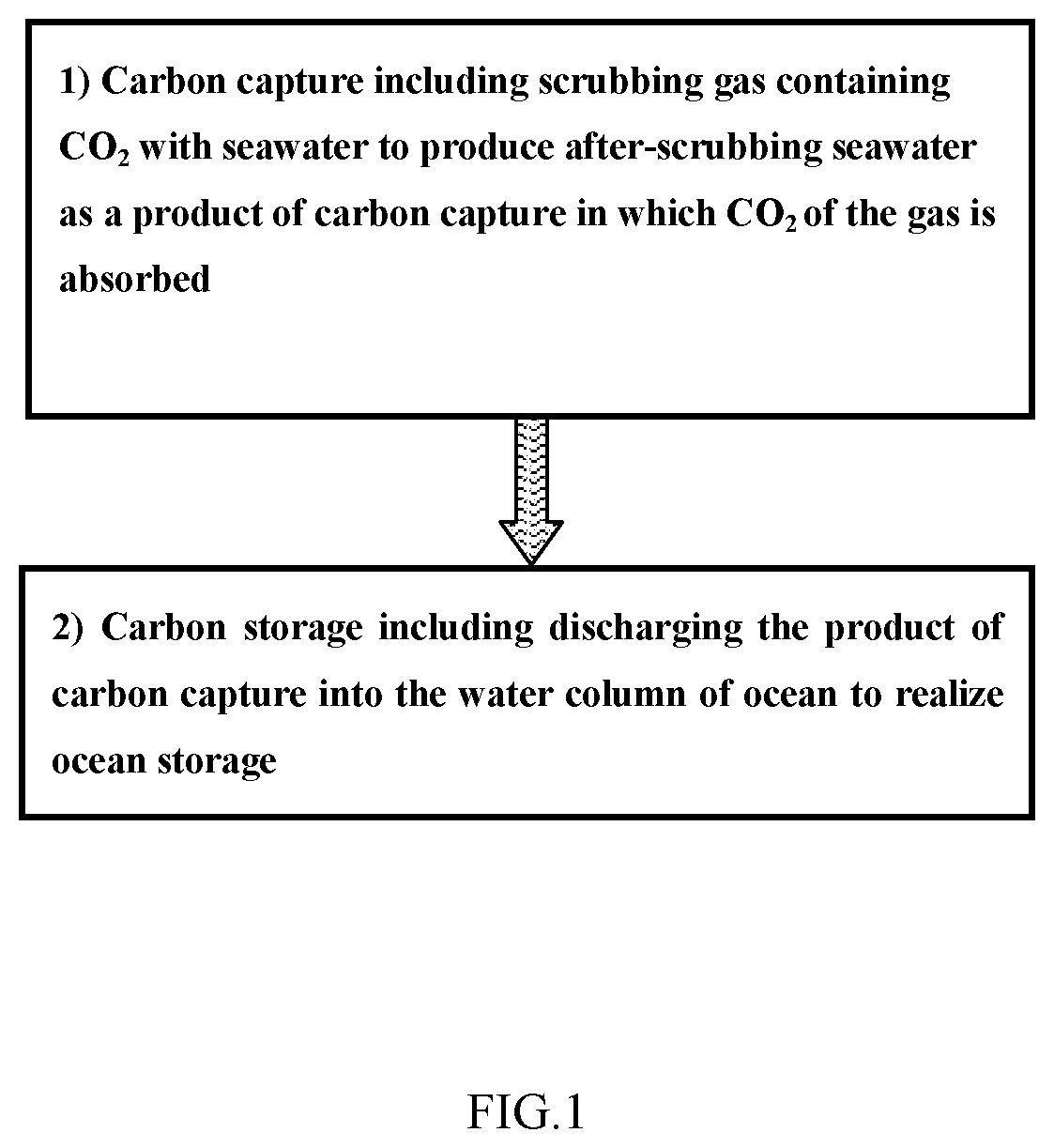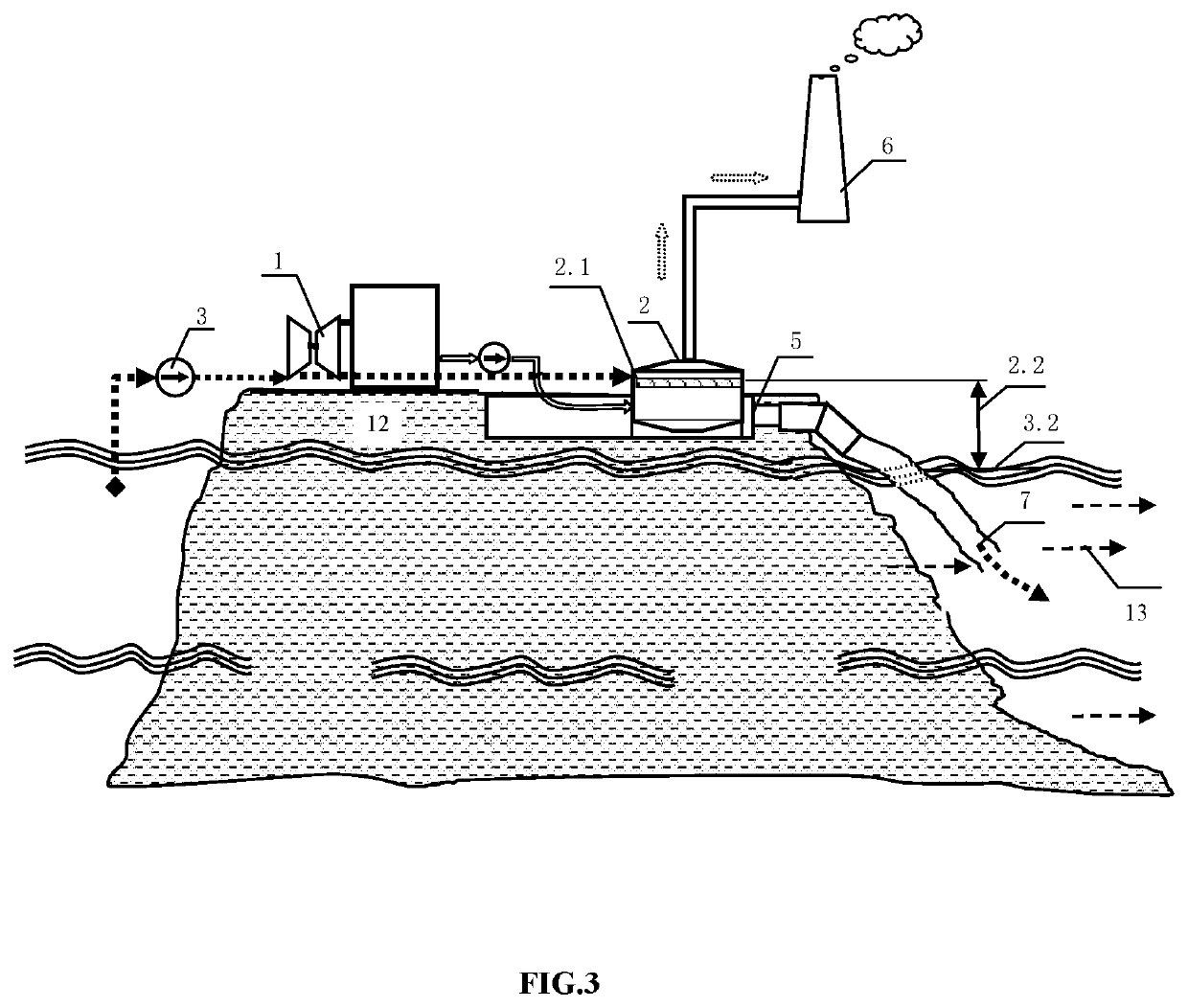Process and apparatus of ocean carbon capture and storage
a carbon capture and ocean technology, applied in the direction of renewable energy generation, greenhouse gas reduction, separation processes, etc., can solve the problems of difficult to achieve large-scale emission reduction, far from the actual application from the economical and affordable aspects, and all existing ccs arts are costly geological storage policies. achieve the effect of cost-effectiv
- Summary
- Abstract
- Description
- Claims
- Application Information
AI Technical Summary
Benefits of technology
Problems solved by technology
Method used
Image
Examples
example 1
[0092]This is a basic example of the process of ocean carbon capture and storage of the present invention. As shown in FIG. 1, the process includes the steps of: 1) carbon capture including scrubbing gas containing carbon dioxide with pumped seawater to produce after-scrubbing seawater as a product of carbon capture in which the carbon dioxide in the gas is absorbed; and 2) carbon storage including discharging the product of carbon capture into the water column of ocean to realize ocean storage.
[0093]In a varied example based on this example, in step 2), the product of carbon capture is discharged into the water column of ocean under atmospheric pressure through a pipe. The whole course from the carbon capture to the carbon storage is a consecutive reaction.
[0094]In another varied example based on this example, the process further comprises adjusting a ratio of volume of the seawater to volume of carbon dioxide in the product of carbon capture to adjust pH value of the product of ca...
example 2
[0097]This is another basic example of the process of ocean carbon capture and storage of the present invention. As shown in FIG. 2, the gas containing carbon dioxide is the flue gas discharged from the burning of fossil fuel and the process includes the steps of: a. continuously leading flue gas containing carbon dioxide which is discharged from a burner for burning fossil fuel into a carbon capture device; b. continuously leading seawater into the carbon capture device; c. providing packings in the carbon capture device to enlarge contact area of the flue gas of step a and the seawater of step b to enhance absorbance of the carbon dioxide by the seawater; d. continuously discharging scrubbed flue gas into atmosphere; e. continuously discharging the seawater containing carbon dioxide generated in step c from the carbon capture device; and f. continuously discharging the seawater containing carbon dioxide generated in step e into a carbon capture location in the water column of ocea...
example 3
[0098]This is an example based on above Example 2. As shown in FIG. 2, at least 10% of carbon dioxide in the flue gas in step a is removed compared with the scrubbed flue gas in step d.
[0099]In a varied example based on this example, at least 20% of carbon dioxide in the flue gas in step a is removed compared with the scrubbed flue gas in step d.
[0100]In more varied examples based on this example, at least 30%, or 40%, or 50%, 60%, or 70%, or 80%, or 90% of carbon dioxide in the flue gas in step a is removed compared with the scrubbed flue gas in step d.
PUM
| Property | Measurement | Unit |
|---|---|---|
| temperature | aaaaa | aaaaa |
| temperature | aaaaa | aaaaa |
| temperature | aaaaa | aaaaa |
Abstract
Description
Claims
Application Information
 Login to View More
Login to View More - R&D
- Intellectual Property
- Life Sciences
- Materials
- Tech Scout
- Unparalleled Data Quality
- Higher Quality Content
- 60% Fewer Hallucinations
Browse by: Latest US Patents, China's latest patents, Technical Efficacy Thesaurus, Application Domain, Technology Topic, Popular Technical Reports.
© 2025 PatSnap. All rights reserved.Legal|Privacy policy|Modern Slavery Act Transparency Statement|Sitemap|About US| Contact US: help@patsnap.com



